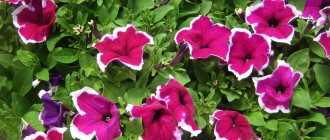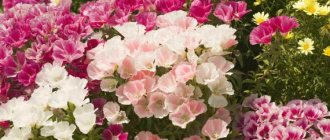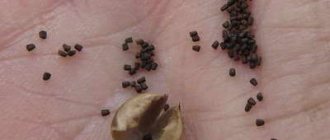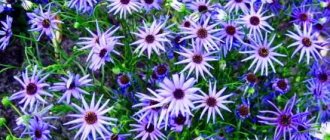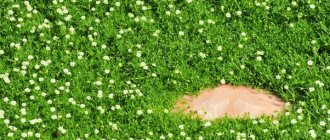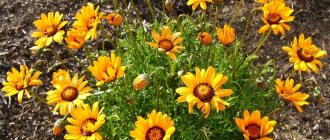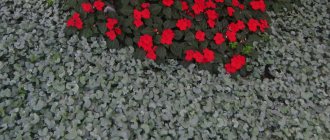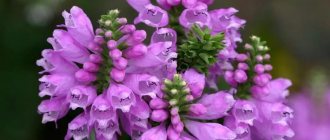Many gardeners want to have some wonderful plant on their plot. At the moment, various innovations are appearing. But I want the plant not only to please the eye, but also to bring benefits. One of these is lagenaria. Its homeland is Africa. People have long used fruits not only for food, but also to make various household items from them, for example, dishes.
The production of the latter, by the way, has survived to this day. Such an interesting activity makes it possible to create amazing household and decorative items.
Description of the magnificent lagenaria
The plant is an annual and belongs to the pumpkin family. Externally, the fruit resembles a cross between a pumpkin and a zucchini. The plant itself is a creeping vine. Lagenaria can reach 15 meters in length. The growth rate is very high. The leaves are quite large, round in shape with a velvety structure. The flowers are also large and usually open in the late afternoon. In the morning they are creamy or pinkish in color; in the evening the shade becomes paler.
The most unusual thing about this plant is the fruit, or rather its shape. It can be varied: elongated, pear-shaped, round, serpentine or bottle-shaped. It depends on the variety of lagenaria. Young small fruits are used for food. They have a pleasant taste and are reminiscent of our zucchini. Ideal for proper and dietary nutrition. They contain many vitamins, minerals and dietary fiber.
This plant has another incredible property. If you don’t want to pick the whole fruit, you can cut off the piece that is needed at the moment. The cut area is quickly covered with film. The lagenaria fruit continues to grow, despite the cut.
What does the plant look like?
Lagenaria belongs to the pumpkin family and, like all its representatives, is an annual. The leaves of this vine are almost the same as those of zucchini: quite large, round, with a velvety surface. Lagenaria has very long vines, up to 15 m, but unlike zucchini and pumpkin, they need vertical support, so the vine is often planted near an arch or gazebo. This way you can “kill two birds with one stone”: decorate the yard with dense foliage and fancy pumpkins, and also give them a chance to ripen. The fact is that if the lashes lie on the ground, the fruits will begin to rot and you will not be able to take advantage of the results of your labor.
True, you can put bedding under them, but, you see, it is difficult to cover such a large area, and there is not always so much free space on the site - it is much easier and more convenient to grow lagenaria on a support.
It is worth noting that the support must be stable, reliable and high. Not only do the shoots stretch a meter in length every week, but also the weight of the fruit in some varieties can exceed 10 kg, and the length - more than 1 m.
It is interesting that lagenaria blooms at the same time as datura or matthiola: delicate white inflorescences with an intoxicating aroma bloom among the foliage after sunset.
Early the next morning, the fully opened flowers have a barely noticeable pink or cream tint, but then turn pale and close by midday.
As for the shape of the fruits, here nature is in full swing: long “mutant cucumbers”, giant pears, round zucchini with a swollen cap that looks like plump overgrown mushrooms, beautiful pumpkin vases with a long neck or even reminiscent of a snake with its sinuous shape ...
In a word, lagenaria can surprise even the most demanding gardeners. Moreover, if desired, the fruits can be given other shapes as your imagination dictates - you just need to tie a young pumpkin with a rope in the right place and it will gradually narrow.
Popular varieties
There are several varieties of lagenaria. Some gardeners have a specific favorite variety, while others group several types together. Thus, unique still lifes are created in the garden plot.
The most common varieties are the following.
- Lagenaria polenida. Growing this species at the initial stage resembles an ordinary zucchini. But as it ripens, the fruit turns out to be very large. It can reach 2 meters in length. And its maximum weight reaches 10 kg. Of course, in order to achieve such indicators, it is necessary to create extremely favorable conditions for the plant. On average, the length of the fruit will be about a meter.
- Growing the Lagenaria serpentine variety is popular. This plant is a little similar to the previous one, but has a more refined shape. The length of the fruit is 40-50 cm. During the season, you can collect about 30 kg of vegetables from the bush.
- Variety Cobra. These fruits are round in shape with an elongated neck. And the part near the cut resembles the head of a cobra. The peel is dark green with light green specks.
- Goose covered in apples has a very decorative appearance. The fruits are very similar in shape to geese. Due to these properties, lagenaria is widely used in landscaping.
- Growing the Lagenaria bottle variety is very interesting. The fruits really look very much like a bottle or a vase. Such fruits look very attractive and unusual. The optimal length is considered to be 50 cm. During this period, the fruits are juicy, the flesh is soft, and the peel is very thin. Afterwards, the fruit begins to harden and becomes unsuitable for food.
- The Lagenaria Kobasa variety is shaped like a huge pear. The standard fruit size is 50 cm. This species is often used for decorative purposes. Amazing vessels and jugs are made from them.
And many gardeners are trying to experiment. When lagenaria fruits are still small, they are placed in objects of a certain shape: square, circle, diamond, etc. Then the fruits will grow according to the scenario that the gardener intended.
The most interesting types of lagenaria
The shape of the fruit of a creeping vine depends on its variety. Most often in the areas you can find the following types of lagenaria:
- calabash;
- bottle;
- log-shaped;
- serpentine;
- cobra;
- goose in apples;
- Swan geese;
- cylindrical;
- warty;
- club-shaped;
- turban.
Some varieties of lagenaria are grown for consumption. Others are so original that, already hanging on the lashes, they are a work of art. They make beautiful decorative crafts. Let's take a closer look at these types of vines.
Lagenaria Calabash
One of the most decorative varieties, the fruits of which are similar to giant pears, up to 50 cm in length, but with an elongated top. Thanks to their narrow neck and wide bottom, they make convenient jugs. With good care, you can grow even a two-meter pear, however, this does not happen very often. Pumpkin ripens 200 days after sowing the seeds. As for the length of the lashes, in a sunny place they can grow up to 15 m.
Lagenaria bottle
The variety is similar to Lagenaria Calabash, only the upper part of the fruit is wider and the bottom is slightly less voluminous. Bottle lagenaria is one of the most compact: the length of its vines does not exceed 3 m, and the pumpkins themselves grow to a maximum of 70 cm in length. The fruits are rarely used for food because they have a slightly piquant taste. Most often, pumpkins are grown for decorative purposes; the seedling method is predominant.
In the scientific literature, the variety is found under the name Bottles.
Lagenaria polenidae
The variety is closest to “domestic” zucchini and completely replicates their shape with even, smooth edges, but only if you take into account that the zucchini will be simply gigantic. If young pumpkins cannot be distinguished from a relative, then over time their length reaches an average of about 1 m, and there are also specimens up to 2 m, and they weigh 10 kg. An impressive zucchini, isn't it? The bush itself is distinguished by good branching, and its leaves are more like pumpkin ones - they are large and covered with light fluff.
Lagenaria serpentine
This is a more elegant and fanciful version of the log-shaped pumpkin - the variety is also characterized by an elongated shape, but the diameter of the fruits is noticeably smaller, and they themselves are intricately curved, like a snake, which is why they got their name. The total length of such a snake usually does not exceed 70 cm, although it is capable of weighing up to 7 kg. The leaf blade of the variety is of medium size, however, the size of the bush is also quite compact: 2 m in height for an adult plant.
Serpentine lagenaria is often grown for culinary interest. The young fruits, no more than 50 cm long, have tasty and sweet “squash” pulp and even leaves that have nutritional value.
Lagenaria Cobra
The variety is distinguished by beautiful fruits of rich dark green color with blurred light green spots and a mysterious shape. The lower part of the pumpkin is smooth and round, and the upper part is curved to the side and thin, while at the very stem the “neck” has a thickening, reminiscent of a snake’s head. When grown at home, Lagenaria Cobra has high temperature requirements, so it is most often grown in the southern zone and only by seedlings, otherwise the fruits do not have time to ripen before the onset of cold weather.
The variety has not only nutritional and decorative value, but also has healing properties - it can help with excess weight, diseases of the heart, blood vessels, kidneys and gastrointestinal tract.
Lagenaria Goose in apples
The variety looks like Cobra: the fruits, wide at the bottom, end at the top with a long curved “neck”, like a goose’s, and also have a dark green color with white spots. Most often, pumpkins have only a neck, but there are also varieties when at the stalk it turns into a slight thickening, and then the lagenaria looks like a goose with a head. If the vine grows on a support, then the hanging pumpkins have a straight neck and do not bend.
You can distinguish Goose and Cobra by looking at the very tip of the pumpkin, at the stalk: in Goose it is either smooth or ends in a “head,” while in Cobra, after the “head,” the fruit becomes thinner again.
The variety belongs to the tall variety; its vines can reach a height of up to 15 meters. On average, the weight of one fruit is 1.5 kg with a total length of 0.5 m, but in a particularly fruitful year and with proper care, specimens weighing up to 8 kg can be grown, with up to 15 pieces per plant.
Lagenaria Goose in apples is distinguished not only by abundant fruiting, but also by excellent keeping quality of the fruit. Pumpkins picked in September can last until spring without losing their taste.
Lagenaria Swan
Another “goose” variety with green spotted fruits. They also grow a long neck, but in Lebedushka it is most often curved to the side, although if you put lagenaria on an arch, the hanging fruits will have a straight neck. The variety is decorative and is not eaten due to the bitter taste of the pumpkins. The vines grow long, the leaves are large and smooth.
Lagenaria Geese-swans
In terms of fruit shape, the variety is almost similar to Goose in apples. You can distinguish these two types of lagenaria by looking at the bush itself. If Goose is a large vine with long lashes, then Swan Geese are compact varieties, because their length does not exceed 1.5 m. In addition, they have smaller leaves.
Interesting souvenirs can be made from unusual fruits, and young zucchini, until they grow to more than 30 cm in length, are used for food purposes.
Lagenaria Mistress
The variety is characterized by strong growth and variety of shapes: pumpkins can be in the form of a bottle, pear or cylinder. The neck is elongated, flat or curved, or thickened at the top. Color varies from clear light green to mottled dark green. The Young Hostess has good taste, and various crafts are made from ripe fruits.
Lagenaria cylindrical
The variety is a cross between serpentine and log-shaped lagenaria: the fruits are elongated, like those of the first, but with smoother outlines, like those of the second variety. But the color is most often rich green, although there are also light green long zucchini. Cylindrical lagenaria at a young age is very tasty in pickled or canned form. The ripened fruits are used to make decorative dishes.
Lagenaria warty
One of the most “ugly” varieties, not everyone undertakes to grow it, but not because of the difficulties of care, but because of the interesting, but repulsive shape of the fruit. However, everything is clear about the shape of the pumpkin - it can be either standard, round and small, or elongated, but quite thick and huge. The color is most often light green or creamy orange. But what is most interesting is the large growths in the form of warts, almost completely covering the lagenaria.
Lagenaria clavidae
The pumpkin, slightly elongated at the bottom, smoothly turns into a long and narrow “neck”, which resembles a club - this is exactly what the fruits of the variety look like. They are light green, with blurry white spots, the leaves of the vine are pale green, medium in size, the bush blooms with large white bells. In a sunny place it grows long vines, and the size of the pumpkin can reach up to 2 m in length.
Lagenaria Turban
One of the smallest varieties in terms of fruit size, thanks to which this lagenaria cannot be confused with other species. Small pumpkins grow no more than 40 cm in length and consist of two rounded parts in the form of independent zucchini, dressed on top of each other:
- the lower one is cream-colored and has a wavy but stable bottom;
- the top one looks like an orange-red cap, the edges of which protrude slightly.
The variety is also called Red, Oriental or Turkish Turban, and the pumpkins themselves can be painted with green stripes, mainly in the lower part. Lagenaria blooms with large yellow inflorescences.
Growing methods
Growing lagenaria is not particularly difficult. However, there are still certain features. The plant belongs to the heat-loving species, because it is southern. Therefore, in warm climate zones, lagenaria is sown with seeds in open ground. But in the middle zone it is better to plant seedlings. Some people prefer to plant the plant in a greenhouse. If you want to get the harvest as early as possible, then already in the first half of April the seeds are planted at home or in greenhouse conditions.
Basically, there are no difficulties when growing lagenaria.
A photo of a plant creates a complete picture of the unusual nature of this species.
Lagenaria: growing a vegetable
Lagenaria: photo
Planting lagenaria seeds and their further cultivation has similarities with growing pumpkins. It is best to sow in April, in the second decade.
We are preparing the seeds. Lagenaria seeds must first be soaked in a cloth. To achieve greater success, you should take water, it should be warm and melted, or add a small amount of simulator to ordinary water for growth and development. After about 4 days, the lagenaria seeds will begin to swell. To provide the plant with the necessary development, the seeds need to be cracked. After which the seeds will again need a habitat with moist and growing conditions. After a couple of days you will be able to notice the appearance of the first shoots. this will indicate that the seeds are ready for use.
We plant in the soil or grow the plant using seedlings. Lagenaria seeds with sprouts can be planted immediately in open soil or you can first start growing seedlings. In the southern regions, the first method is preferred. The regions of the middle zone, the Urals and Siberia, of course, choose to grow using seedlings. It is important to understand that the plant is considered fully mature 90-100 days after its planting. Decorative varieties should remain on the vine for at least about 1 month, but the skin on the fruit must become completely hard so that the plant can endure the winter period without negative consequences. If the fruits are not fully ripe, they may begin to rot. Those seeds that have sprouted need to be planted in separate containers; it is better to use seedling cups, which need to be filled with standard seedling soil. Caring for the plant comes down to keeping the substrate moist. After 30 days, the seedlings can already be planted in open soil. An important condition is that there should be no risk of a return of winter frosts. Seedlings should be placed on the south side of the building. You need to prepare the soil in the same way as for growing zucchini or pumpkins, the only difference is that the reaction should be neutral or slightly alkaline. At the same time, it is also necessary to provide for the installation of supports for vines that will gain their power.
Growing lagenaria from seeds
Before sowing, it is better to pre-soak the seeds. To do this, you need to take a piece of cloth and place the required number of seeds there. Pour the material with the seeds inside with warm water and leave it in it for a while. The ambient temperature should not be lower than room temperature.
As soon as the first sprouts appear on the surface, the seeds are placed in containers for seedlings. At first, it is necessary to create greenhouse conditions for them. This can be done using film. But it is important to remember that as soon as the sprouts emerge, remove the film immediately, otherwise they will become very elongated. Seedlings are planted in open ground in June, as soon as warm, stable weather sets in.
If the local climate is warm enough, then the seeds can be sown directly in open ground. To do this, thin out a shallow furrow and fill it with hot water. You can also use a weak solution of potassium permanganate. Afterwards, it is better to cover the planting site with polyethylene. This method helps the plants grow faster.
Planting lagenaria in open ground
How to plant lagenaria seedlings in open ground photo
For a heat-loving crop, it is necessary to choose a warm, windless place. Lagenaria is often planted along the walls of buildings or fences along which it weaves. Lighting is required from the sun, so when planting this way, choose the south side. During the season, the plant reaches a length of more than 4 m. You can also install a support on a trellis and grow gourd pumpkin on it. Take care of the support immediately upon landing. The plant will cling with tendrils.
The soil needs to be fertile and loose. The quality of the soil should be improved in advance - in early spring, or better yet, in the fall, add humus or compost. The nutrient mixture can be added directly at the time of planting. Dig the soil to a depth of 40 cm, add humus, wood ash and complex mineral fertilizer to each hole.
Scheme for planting lagenaria seedlings:
- Keep a distance of 1.2-1.5 m between plants.
- Row spacing is 1.5-2 m.
Carefully remove gourd pumpkin seedlings from pots or cups and plant them in prepared holes, deepening them down to the cotyledon leaves. It is advisable to add a little humus and ash to the holes, mixing with garden soil.
Press the soil around the seedlings a little with your hands and water. To maintain soil moisture, mulch the plantings with hay, straw or sawdust. If you just grow in a garden bed without support, in the future place planks, stones or pieces of cardboard under the fruits to protect them from excess moisture and prevent slugs from eating the fruits.
If immediately after planting there is a risk of frost, it is necessary to protect the plantings from the cold with covering material or film.
Seedling care
The seedlings are quite undemanding to care. But it is very important to provide her with good lighting. Water as needed. But the main thing here is not to overdo it. Excessive moisture will damage the young plant. But you shouldn’t overdry the soil either. To avoid this, it is better to cover the ground near the trunk with mulch. The optimal temperature for growing lagenaria is 15-20 degrees Celsius.
The seedlings are ready for transplanting into open ground no earlier than in a month. The height should be from 10 cm. A week before transplantation, a hardening procedure must be carried out. Take the seedlings outside every day, gradually increasing the time spent in the fresh air. Thus, the young plant will tolerate replanting more easily and will quickly begin to please its owners with a bountiful harvest.
Planting lagenaria seeds in the ground
With long warm summers and warm autumns without frost, you can plant gourd pumpkin seeds in the ground. This is done when the soil warms up to a depth of 10 cm to at least 12°C.
Make small holes so that it is convenient to water later, and plant 2-3 seeds in them. Then 1-2 viable sprouts are left. The distance between holes is 1.2-1.5 m. Row spacing can be left up to 2 m wide.
Features of planting and caring for the plant
It is necessary to choose the right place for planting. When growing and caring for lagenaria, it is worth considering that this is a branched plant. Therefore, it must be placed next to the support. For this purpose, you can use a piece of site decor, a gazebo, a veranda or part of a fence. The plant grows very quickly. And a branchy flowering vine on a personal plot will look simply magnificent. But at the same time, it is worth considering that the landing site should be sunny.
The distance between plants should be at least 70 cm. Holes for planting are dug 30 cm in length and width. The depth of the hole is approximately the same. Peat, compost or humus is placed at the bottom of the hole. It is also worth adding a little ash. The root part is carefully buried and watered generously with warm water.
As the shoots grow, they need to be guided along the support.
If support is not provided, then the near-root space must be covered with boards. Otherwise, the fruits will simply begin to hurt or rot.
Lagenaria - what kind of plant is this?
What kind of miracle vegetable is lagenaria and what to do with it?
Seeing it for the first time, you are at a loss: is it either a zucchini, or a pumpkin, or a cucumber... The leaves are similar to pumpkin ones, at the beginning of fruiting the vegetable looks like a cucumber, and then - like a zucchini both in color and taste. For food purposes, the young fruit should be used while its skin is soft and tender. Then it coarsens so much that the pulp can be scraped out, and the shell can be dried and used as utensils. Thanks to the bizarre shape, you will get original jugs, vases, and excellent containers for storing bulk products. So, common lagenaria (Lagenaria siceraria) is an annual vine-like creeping plant of the pumpkin family. There are other names: calabash, gourd, Indian cucumber, Vietnamese squash, bottle gourd, etc. The plant is native to India and also lives in the natural environment of Latin America, Africa, and Asia.
Pollination rules
An important feature of growing lagenaria is the pollination process. The plant has male flowers, or as they are also called, barren flowers. And, accordingly, women's. Since the buds bloom in the late afternoon, there is no one left to pollinate them. Therefore, to obtain a harvest, you need to do pollination yourself. To do this, you need to take a brush or cotton swab and transfer pollen from male inflorescences to female ones. The latter, as a rule, are located closer to the lower part of the plant and have a short stalk. In male flowers it looks completely different. The leg is thin and elongated. Pollination can be carried out in the morning or evening.
How to dry lagenaria for crafts
How to dry lagenaria for crafts
When to remove lagenaria?
Lagenaria fruits are left on the plant for as long as possible, until they are fully ripened. When there is a threat of frost, they are removed from the plant, cutting off the tail with a sharp knife, but without breaking off. This will prevent rotting in the future.
How to dry
After this, the pumpkins are hung in a well-ventilated area or arranged so that they do not touch each other. You can dry it under a canopy, as long as it is dry. Check your pumpkins several times a week and remove any that are rotten. Wait for the outside of the pumpkin to dry thoroughly, this will take 1-2 weeks. Then you can treat the surface of the lagenaria with chlorhexidine, purchased at the pharmacy: rinse the pumpkins thoroughly and wipe dry. After this, they can be moved to a dark room with good ventilation.
How long does it take for lagenaria to dry?
The process may take until spring, about 6 months in total. Check and turn the pumpkins regularly to ensure they don't rot and dry evenly. The signal that you are ready to use for crafts will be a ringing sound when shaking the pumpkin: the dried seeds inside will rattle loudly.
Reproduction of lagenaria
You can collect the seeds yourself from your vines. The first fruit is left for these purposes. It matures throughout the season. Cut before the first frost. After this, the pumpkin is stored at home for a month. The fruit is then cut and the seeds are extracted.
The seeds need to be dried a little, but only in their natural environment. The seeds are stored in a paper or woven bag. The shelf life is 7 years.
How to care for lagenaria
How to grow lagenaria
How to pinch a gourd pumpkin
When the main stem reaches 1.5-2 m, pinch off the top. Next, when the plant begins to grow, similarly pinch the tops of the side shoots. Leave no more than 5 fruits on one bush, and if you want them to grow long and large, no more than 2-3.
Pollination
From the moment of emergence of seedlings to the beginning of flowering, about one and a half months pass. The flowers are large, goblet-shaped, there are male and female. The peculiarity of the gourd gourd is that its buds open in the late afternoon and are pollinated by nocturnal insects, so if you doubt that moths will cope, you can help with pollination yourself. Take a brush with very soft bristles and carefully brush over the stamens and pistils of the flowers, one after the other. This will transfer pollen from one flower to another and achieve pollination.
Watering
Like all pumpkin plants, lagenaria loves water very much. You need to water at least 2-3 times a week, preferably in the afternoon, but not late in the evening, so that the water on the leaves has time to dry before sunset. Throughout the season, be sure to remove weeds and periodically loosen the soil surface, avoiding deep penetration of the tool (no more than 5 cm). It is better not to pull at the trunk of the plant at all, but to rake it with a mini-rake so as not to damage the roots.
Feeding
- The first fertilizing is applied even when planting the seeds (if you sow directly into the ground): put a handful of humus in the hole, a grind of ash, mix with garden soil and plant the seeds.
- The second feeding is applied at the stage of 5-6 leaves. It is necessary to apply nitrogen-containing fertilizers: saltpeter or urea. Dilute 1 tablespoon in 10 liters of water and pour 0.5 liters of solution under the bush.
- If you are planting seedlings, feed them for the first time 10 days after planting with the same nitrogen-containing preparations.
- The following feeding will be needed during flowering: feed with potassium-phosphorus fertilizers or ready-made complex preparations. Nitroammophoska, which contains potassium, phosphorus and nitrogen, is perfect. Take 2 tablespoons per 10 liters of water, stir and water 1.5-2 liters per bush.
- When the fruits begin to set, feed the lagenaria with yeast: take 10 grams of dry yeast and 2 tablespoons of sugar per bucket of water. Ferment for two hours and dilute in a ratio of 1:5. Water at the rate of a bucket of infusion for 4-6 plants. Yeast is an excellent growth stimulant; this fertilizing promotes active fruiting and the growth of green mass.
Harvesting
The fruits ripen within 1.5-3 months. The yield from one bush is about 40 kg. As stated earlier, the fruits must be picked while the skin is soft to be eaten. Do you think that you have already learned everything about the exotic lagenaria? But no! Another amazing property of the unusual pumpkin is that you don’t have to pick the fruits, but simply cut them off partially - the cut area becomes corked and the fruit continues to grow.
Growing lagenaria at home
It’s very surprising, but many people grow this plant at home. Lagenaria feels no worse on the loggia or balcony. If you decide, for example, to grow bottle lagenaria practically in your apartment, then you need to take into account the following aspects:
- you need a pot with a volume of at least 10 liters, and preferably 15 (the vine has a fairly powerful root system, so the plant will not develop and bear fruit in a cramped container);
- a layer of drainage material at least 3 cm thick must be placed on the bottom of the pot;
- You can use any soil that contains humus.
Growing Lagenaria serpentine does not have to be grown only in the summer. She feels great throughout the year. But with the onset of cold weather, the vine will need to be brought home. And it is advisable to place it near a window on the south side. This way the plant will receive more sunlight.
Otherwise, home growing is no different from garden growing. Once every two weeks, fertilizing and timely watering are recommended. And, of course, to form ovaries, carry out pollination.
Lagenaria: description of the vegetable
Lagenaria: video
Lagenaria (this plant is also called Indian cucumber, Vietnamese squash, cucurbita, calabash, gourd, musical pumpkin) is an annual plant that looks like a fast-growing herbaceous vine. An interesting type of plant is a representative of the Pumpkin family. The long vines of the plant can reach a length of up to 15 m in one season and bring a good harvest - about 15 pumpkins with a bizarre shape and unusual color. The plant has about 7 varieties, which include both edible species and plants that are grown exclusively for decorative purposes. Domestic summer residents most often grow lagenaria vulgaris, which can amaze with its unusual shape. Depending on what variety the plant belongs to, it can take the form of geese, nesting dolls, and snakes. The flowers of the plant are large in size, but you can see them in all their beauty, when open, only in the evening. It is important to note the fact that in ancient times, the plant was grown only for various household needs - durable dishes were obtained from the fruits of the plant, which were used to store liquid and bulk items. Many scientists say that the plant appeared about 9-10 thousand years ago. The country of origin is considered to be South America. The plant literally got to other countries and continents through the sea - the fruits of the plant do not drown in water, so they fell into the sea and thus washed up on the shores of other continents, where they took root and sprouted quite quickly and easily. Lagenaria vulgaris is an edible variety whose taste is similar to that of ordinary pumpkin. Inedible varieties contain various poisonous elements. Also, many praise this plant for various healing properties, which are much richer than those of zucchini, melons and cucumbers. However, most often the plant is grown for decorative purposes.
Harvesting
When growing lagenaria in the Moscow region, harvesting is carried out multiple times. Usually the first harvest appears 3 months after planting the seeds. But the timing depends on the purpose of cultivation. For consumption, the fruits are cut earlier and more often. For the manufacture of decorative dishes and various crafts, the fruits ripen longer. Remove the pumpkins when they grow to the desired size.
Growing lagenaria is a truly interesting and practical activity. There are a large number of recipes in which lagenaria is an ingredient. The fruits will not only act as food, but will also become an excellent decoration for the site. And if you show your imagination, you can decorate your home interior with ripe fruits.
Cooking recipes
Lagenaria is no less interesting from a culinary point of view - what kind of plant it is and what it is eaten with. In most edible varieties, not only unripe fruits are used, but also flowers, leaves, and young, rough shoots.
Pasta with serpentine lagenaria
When used in cooking, the pulp of cucurbita does not differ from zucchini or pumpkin; it can only be consumed fresh, without heat treatment. The limitation is due to the fact that unripe lagenaria pumpkins are bitter.
To prepare dishes from unusual pumpkin, any recipes that use pumpkin or zucchini are suitable. In this regard, what lagenaria is as a vegetable and what it is eaten with is determined by the imagination of the cook.
Distribution and habitat
Lagenaria plantation
The homeland is considered to be Africa, the territory of modern Zimbabwe. From where it spread through Central Asia to China. Possessing water resistance, a strong wall and buoyancy, the fruits were carried by sea currents to the American continents. In human culture, lagenaria vulgaris was used as utensils even before the use of pottery and was discovered in excavations dating back to 4000 BC.
The gourd is usually grown in tropical or subtropical areas such as Africa, South America or China.
In cultivation in the conditions of central Russia, lagenaria vulgaris can only be grown by seedlings and in greenhouses and greenhouses[11][ unauthorized source?
][12][
unreputable source?
].
Application in landscape design
African chamomile is widely used to decorate lawns, balconies, and large areas. Why is growing gatsania considered beneficial for designers? The answer is most unexpected: the flower is unpretentious in care and can survive drought.
There is one more feature: you can create a full-fledged pattern from the variety of colors of the crop.
Reason: flowering in the first year of life occurs no earlier than after 50-60 days. If the seeds are planted immediately in open ground, the plant does not have time to fully develop. Winter cold kills crops.
Provided that the seedlings are prepared, the gardener can only plant them in the desired pattern and shape. Then enjoy decorating the garden. This same feature allows planting in areas with a temperate climate and short summers.
Features of growing lagenaria, choosing a place for planting
Often lagenaria choose a place for planting so that it can delight not only with fruits, but also with all its green mass. It weaves around gazebos, fences, and trees as an ornamental plant. At the same time, minimal care is required.
Warmth and light for lagenaria
Just like a regular cucumber or pumpkin, the gourd pumpkin loves warmth and a lot of light. At temperatures below 15 °C, its seeds do not germinate, and young shoots develop very poorly in the shade. An adult plant can do well in the shade of a tree, using its trunk as a support. Therefore, it is best to choose open, illuminated areas for growing crops, where there will be maximum heat in the summer. But at the same time they must be protected from wind and drafts. The ideal place for lagenaria is the sunny side of trees, fences, gazebos, and house walls.
Did you know? The vegetable has not only high yield, but also a fantastic growth rate. Just a couple of weeks after the ovary, the fruit reaches one and a half meters in length.
Alternatively, you can place lagenaria in a greenhouse or greenhouse. In this case, you are guaranteed to receive the expected harvest. The greenhouse must be at least two meters high and have vertical trellises inside along which the plant will climb.
What kind of soil does Lagenaria like?
Lagenaria or, as it is also called, bottle gourd requires fertile soil with good drainage properties and low acidity. To do this, lay out a layer of expanded clay or broken brick 3 cm high on the bed and sprinkle it with soil, or you need to dig up the soil with sand.
In the fall, it is recommended to saturate the soil with the necessary fertilizers.
In the fall, biomass from leaves, bark, sawdust, tops is laid out at the proposed planting site and sprinkled with lime on top. After wintering in the spring, this mass is covered with manure and sawdust, in which seedlings can be planted.
DIY lagenaria crafts photo
Vase from lagenaria with a burnt pattern photo
Lagenaria dishes have been used since ancient times and served their owners for a long time. Why not do something similar with your own hands? The easiest way to make a craft from lagenaria is to burn some kind of design or ornament. A minimum of time is spent, and the decorative effect is impressive.
Flask for lagenaria wine photo
Carefully scraped and sanded inside, lagenaria will be an excellent vessel for drinks. Why not give this gift to your friends by filling a flask with homemade wine? Rest assured, this will become a real event and will be remembered for many years!
Lagenaria craft with carvings photo
If you have experience in wood carving or a burning desire to learn it, try to create something like this: openwork carving, voluminous scraped designs and painting will make a lagenaria craft a real masterpiece!
Simple do-it-yourself lagenaria vase photo
Even simple multi-colored stripes with blurred boundaries look original on an unusual pumpkin vase. Turn on your imagination and get unforgettable pleasure from the creative process.
Lagenaria vase with enamel surface and Gzhel painting photo
It's hard to believe that such a work of art was created from an ordinary pumpkin! But it’s not for nothing that in ancient China, vases made from lagenaria were highly valued, being an integral attribute of the life of Chinese emperors.
Crafts from gourd pumpkin photo
Autumn motifs and folk design styles are timeless classics when it comes to crafts. Why not try making something similar with your own hands?
Lagenaria craft with photo painting
You can burn out the outlines of the drawing and make a colorful painting in a fantasy style: it turns out very beautiful.
Lagenaria products photo
Unusual crafts made from bottle gourd are very original in any design, because the very opportunity to make unusual dishes from a natural fruit is already a real miracle. And by adding imagination and patience, you can create real hand-made masterpieces.
When and how to collect plant seeds
It is difficult to collect seed material on your own due to the short summer. If the season was hot, autumn was dry, and there was little rain, then the seeds will ripen safely. Identify the seed sac by its shape: it resembles a dandelion.
To prevent the seeds from scattering, the box is packed in a bag or fabric base. A light breeze will blow them away if you do not prepare in advance for the moment of ripening.
Semi-dry inflorescences are suitable for collection, but must be healthy. When the seeds fall into the trap, the bag is removed. Additional grains are dried in it and stored in a dry, dark place. The shelf life of gatsania material for seedlings is 2 years.
Planting gatsaniya for seedlings: cultivation technology and care rules
African chamomile is often found in front gardens in summer cottages. The bright beauty belongs to the aster family. It was brought from South Africa in the early 17th century.
Red-orange, lemon-yellow flowers open after sunrise - this feature gave rise to a new name - “midday sun”.
The African flower can be planted in the ground as a seed, but gatsania seedlings will take root better and give positive results if grown at home.
Lagenaria vulgaris in art
Tacuinum sanitatis
page . 1390
Lagenaria was quite widely depicted by artists as both a vegetable and products made from it. In particular in:
- manuscripts of the Julian Anivia Codex (1503-1508) and in Tacuinum sanitatis;
- frescoes of the Villa Farnesina (1515-1518);
- paintings: Andrea Mantegna - “Merry Christmas Catholics. Adoration of the Magi" (1450); Peter Aertsen - “Woman at the Vegetable Market” (1567); Giuseppe Arcimboldo - “The Seasons. Autumn" (1591-1592); Michelangelo Merisi da Caravaggio - “Fruit” (1599), “Fruit, Vegetables, Flowers” (1602); Joachim Uttewaal - “Lot with his daughters” (1600); Hendrik Goltzius - “Lot with his daughters” (1616); Frans Snyders - “Philopoemen”, “Vegetable shop”, “Fruit shop”, “Vegetables and fruits” (1618-1621); Diego Rodriguez de Silva y Velazquez - “The Dwarf Don Juan Calabaza, called Calabazilla” (1638); Jacopo da Empoli - “Still Life” (1625); Peter Paul Rubens - “The Statue of Ceres”, “Ceres and Pan” (1640); Gerbrandt Jans van den Eeckhout - “The Hermit’s Prayer” (1663), “Children in the Park” (1671); David Teniers the Younger - “The Shepherd Boy” (1670), “The Meeting of Saints Anthony the Great and Paul” (1682); Vereshchagina V.V. - “Sellers of dishes in Uzbekistan”, “Dervishes in festive outfits. Tashkent", "Chorus of Dervishes Begging for Alms. Tashkent", "Beggars in Samarkand" (1870), "Triumphing" (1872), "At the Door of the Mosque" (1873); Kuznetsova N.D. - “Study for the painting “At Work”” (1883).
- Andrea Mantegna - “Merry Christmas Catholics.” Adoration of the Magi" (on the left on the fence)
- Peter Aertsen - "Woman at the Vegetable Market" (bottom left)
- Caravaggio "Fruit" (middle)
- F. Snyders "Fruit Shop" (bottom left)
- Joachim Uttewaal "Lot with his daughters" (attached to a staff in the middle)
- Gerbrandt Eeckhout “Children in the Park” (on the boy’s belt)
- Vereshchagin V.V. “Dervishes in festive attire. Tashkent"
Decorative pumpkin lagenaria: application
Cooking
Young fruits are used like zucchini: stewed, fried, cooked with caviar, canned.
Decorative purposes
Crafts from lagenaria or gourd pumpkin photo
Lagenaria grows quickly and entwines structures. It is often grown to decorate an arch or gazebo, and the fruits are not picked. After special processing and drying, they can be used to make vessels and various crafts.
As a rootstock for valuable crops
Lagenaria has a powerful root system: the main root penetrates about 80 cm deep into the soil, and the lateral roots spread about 3 m in width. Due to this, it is used as a rootstock when grafting valuable varieties of melons (watermelons, melons).
